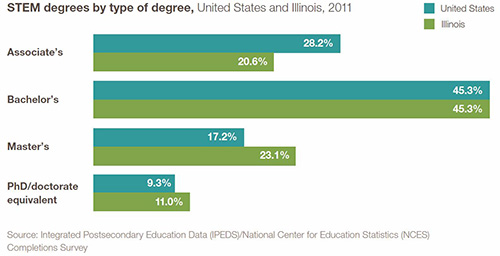The quality of the region's labor force is critical for sustaining economic prosperity, as noted by GO TO 2040. In today's global economy, future job growth will increasingly rely on the availability of well-educated, skilled workers. As described on our Policy Updates blog, a June 2013 Brookings Institution report highlighted how a major component of this skilled workforce will come from positions in science, technology, engineering, and math (STEM) fields. The latest quarterly edition of the Illinois Innovation Index also focuses on worker talent by tracking attainment of STEM degrees, employment and postings in STEM fields, and attraction and retention of a key innovation cohort (those aged 25-34) in the State of Illinois and metropolitan Chicago region. Together, these data sets tracked by the Index help describe the supply and demand of the region's STEM workforce and show mixed results—while progress has been made, metropolitan Chicago lags behind peer regions in key indicators, suggesting the region can do more to develop its highly skilled STEM workforce.
Demand for STEM positions
The Index's analysis of the past decade of STEM employment in metropolitan Chicago shows fluctuating demand for STEM workers in the region. As in other parts of the economy, STEM employment in metropolitan Chicago contracted during the decade's two recessions. Yet while many regions faced difficulties maintaining demand for STEM positions during economic recession, the challenges appeared more acute in metropolitan Chicago. During this time, the region became less specialized in major STEM occupations such as engineers or physical and life scientists compared with the national average.
Since 2010, demand for STEM workers in the Chicago region has rebounded, adding 2,500 positions in 2011 and nearly 5,000 positions in 2012. Research from Georgetown University's Center on Education and the Workforce suggests this uptick will continue as STEM becomes more integral to future economic competitiveness.
Supply of STEM workers
Fulfilling the recent demand for STEM positions will require metropolitan Chicago to develop a corresponding supply of prospective workers with requisite STEM skills. The Index examines this topic by analyzing the region's current and upcoming supply of skilled innovation workers. One way for workers to gain necessary STEM skills is through postsecondary training, and the Index reports that STEM degrees conferred in Illinois have increased by 40 percent over the last decade. As the chart below illustrates, more individuals in Illinois earn master's and doctorate degrees in STEM relative to the national rate. This is an encouraging indicator because workers often translate this advanced graduate level training into marketplace innovations. In contrast, fewer of the state's STEM degrees come from the associate level compared to the national average. As highlighted in our recent Policy Update on the Brookings report, this matters because some of the region's largest and fastest growing STEM positions typically attract workers with less than a bachelor's degree.

While the supply of STEM students trained at Illinois-based institutions has increased this past decade, not all graduates stay in the state to contribute to the innovation workforce. Indeed, a key challenge has been to keep top talent in the region and state following graduation, especially as demand for STEM workers in metropolitan Chicago fluctuates.
To gauge how well metropolitan Chicago attracts and retains skilled workers, the Index analyzes U.S. Census Bureau estimates of regional migration patterns between 2006-10. The Index focuses on those aged 25-34 as a proxy indicator, hypothesizing that this age cohort best represents the career decisions of recently educated workers more likely to contribute to innovation. Due to data limitations, these estimates simply depict flows between metropolitan Chicago and 28 other regions, but this limited sample provides valuable insights on regional workforce trends. Over this four-year period, metropolitan Chicago experienced a net loss of an estimated 8,841 residents aged 25-34 to 28 other regions, with the largest outflows to Los Angeles, Denver, Phoenix, and other western metropolises. At the same time, the region succeeded in attracting other Midwestern residents: Nine of the top ten regions with net inflows to metropolitan Chicago were from nearby regions with university towns such as Madison, WI or Ann Arbor, MI, representing an infusion of talent into the region.
Conclusion
Recent data from the Illinois Innovation Index on STEM employment, attainment, and retention show mixed results for the Chicago region. Over the past ten years, regional STEM employment has not kept pace with peer regions. However, recent growth suggests a rebound in demand. While firms in the region can draw on the growing number of STEM graduates trained at Illinois institutions and continue to attract talent from Midwestern university towns, the region must address an overall net loss of young professionals.
To build the type of workforce that can translate STEM skills into innovation and economic growth, the region should turn to its strengths. A second Policy Update in this two-part series will show that among all STEM fields, metropolitan Chicago maintains a unique concentration in computer and information technology, and this specialization may present growth opportunities across a wide swath of the regional economy.